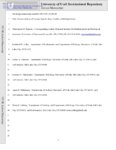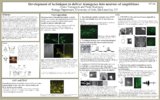|
|
Creator | Title | Description | Subject | Date |
| 126 |
 |
Shapiro, Michael D. | Cynodont from the Upper Triassic of East Greenland: tooth replacement and double-rootedness | A new genus and species of cynodont from the Upper Triassic Fleming Fjord Formation of East Greenland possesses double-rooted postcanine teeth and a nonalternate pattern of tooth replacement. The specimen represents an addition to the known diversity of Early Mesozoic taxa with multi-rooted dentitio... | Mitredon cromptoni; Cynodont; Upper Triassic; East Greenland; Fleming Fjord Formation; Tooth replacement; Double-rootedness; Multi-rooted dentition | 2001 |
| 127 |
 |
Bohs, Lynn A. | Cyphomandra (Solanaceae) | Cyphomandra betacea (Cavanilles) Sendtner Syn. Cyphomandra crassifotia (Ortega) Kuntze, Solanum betacea Cavanilles, Solanwn crassifolium Ortega. Ref. FB 13(5B/1) 1962: 12; Bohs, 1986: 170. Cultivated tree. Andean II. 1000-3000 m. Voucher: Nunez et al. 8257 (MO!) Depts.: AM, CU, HU, SM | Cyphomandra; Solanum | 1993 |
| 128 |
 |
Bohs, Lynn A. | Cyphomandra (Solanaceae) | Unusual ecological aspects of Cyphomandra include its pollination syndrome and herbivore relationships. Male euglossine bees may be important pollinators of Cyphomandra flowers, and the primary attractants may not be pollen, but odor substances secreted by the anther connectives. Specialized herbi... | Cyphomandra; Latin America | 1994 |
| 129 |
 |
Beckerle, Mary C. | Cysteine-rich protein family of highly related LIM domain proteins | Here we describe a family of closely related LIM domain proteins in avian cells. The LIM motif defines a zinc-binding domain that is found in a variety of transcriptional regulators, proto-oncogene products, and proteins associated with sites of cell-substratum contact. One type of LIM-domain protei... | LIM domains; Chicken embryo fibroblasts; Quail embryo fibroblasts; Cell growth; Cell development; Cysteine-rich proteins | 1995 |
| 130 |
 |
Beckerle, Mary C. | Cytoskeleton-associated PDZ-LIM protein, ALP, acts on serum response factor activity to regulate muscle differentiation | In this report, an antisense RNA strategy has allowed us to show that disruption of ALP expression affects the expression of the muscle transcription factors myogenin and MyoD, resulting in the inhibition of muscle differentiation. Introduction of a MyoD expression construct into ALP-antisense cells... | Skeletal muscle; PDZ-LIM protein; Actin; Actinin-associated LIM proteins; Serum response factor; Cytoskeletal architecture | 2007 |
| 131 |
 |
Clayton, Dale H. | Darwins finches combat introduced nest parasites with fumigated cotton | Introduced parasites are a threat to biodiversity when naïve hosts lack effective defenses against such parasites [1]. Several parasites have recently colonized the Galápagos Islands, threatening native bird populations [2]. For example, the introduced parasitic nest fly Philornis downsi (Diptera:... | | 2014-01-01 |
| 132 |
 |
Adler, Frederick R. | Deconvolution of isotope signals from bundles of multiple hairs | Segmental analysis of hair has been used in diverse fields ranging from forensics to ecology to measure the concentration of substances such as drugs and isotopes. Multiple hairs are typically combined into a bundle for segmental analysis to obtain a high-resolution series of measurements. Individua... | | 2014-01-01 |
| 133 |
 |
Adler, Frederick R. | Defended fortresses or moving targets? Another model of inducible defenses inspired by military metaphors | We use a common framework to compare three models of plant strategies to confront herbivory: constitutive defense, optimal inducible defense, and the "moving target." Plants with constitutive defenses retain a fixed defensive phenotype. Plants with optimal inducible defenses respond to attack by inc... | Constitutive defense; optimal inducible defense; phenotype | 1994 |
| 134 |
 |
Olivera, Baldomero M. | Defining a clade by morphological, molecular, and toxinological criteria: distinctive forms related to Conus praecellens A. Adams, 1854 (Gastropoda: Conidae) | We carried out a definition of the Conus praecellens A. Adams, 1854, species group using a combination of comparative morphological data, molecular phylogeny based on standard genetic markers, and toxinological markers. Prior to this work, Conus praecellens was generally postulated to belong to a cl... | Turriconus; 12SrRNA sequences; Phylogenetic analysis; Conus praecellens; Exogenes | 2010 |
| 135 |
 |
Farmer, Colleen G. | Dendrobates auratus (green and black poison dart frog). Larval Predation | Dendrobates auratus was intentionally introduced onto the island of O'ahu, Hawai'i in 1932 from Taboga Island, Panama for mosquito control. Phelsuma laticauda was accidentally introduced from Madagascar in 1996 to the University of Hawaii at Manoa. Both species are well established in the Manoa Val... | Dendrobates auratus; Phelsuma laticauda | 2007 |
| 136 |
 |
Adler, Frederick R. | Departure time versus departure rate: how to forage optimally when you are stupid | Foragers unable to leave a patch at the optimal moment must act as constrained foragers. Extending the results of Houston and McNamara (1985), we compare a blundering forager that leaves patches at a constant rate with an unconstrained optimal forager that leaves patches at the optimal time. | Blundering Foragers; Foraging; Marginal Value Theorem | 1999 |
| 137 |
 |
Capecchi, Mario R. | Detection of targeted GFP-Hox gene fuogenesissions during mouse embry. | The ability to use a vital cell marker to study mouse embryogenesis will open new avenues of experimental research. Recently, the use of transgenic mice, containing multiple copies of the jellyfish gene encoding the green fluorescent protein (GFP), has begun to realize this potential. Here, we show ... | Chimera; Crosses, Genetic; Gestational Age; Green Fluorescent Proteins; Mice, Inbred C57BL; Phenotype | 1998-10-27 |
| 138 |
 |
Yamaguchi, Ayako | Development of an acute method to deliver transgenes into the brains of adult Xenopus laevis | The central vocal pathway of the African clawed frog, Xenopus laevis, is a powerful vertebrate model to understand mechanisms underlying central pattern generation. However, fast and efficient methods of introducing exogenous genes into the neurons of adult X. laevis are currently not available. Her... | viral vector; vesicular stomatitis virus; Xenopus laevis; transgene; neurons; vocalizations; central pattern generator; electroporation | 2018 |
| 139 |
 |
Yamaguchi, Ayako | Development of techniques to deliver transgenes into neurons of amphibians | Society for Neuroscience Meeting 2017 | viral vector; Xenopus laevis; vocalizations | 2017 |
| 140 |
 |
Capecchi, Mario R. | Developmental defects of the ear, cranial nerves and hindbrain resulting from targeted disruption of the mouse homeobox gene Hox-1.6. | Gene targeting in mouse embryo-derived stem cells has been used to generate mice with a disruption in the homeobox gene Hox-1.6. Mice heterozygous at the Hox-1.6 locus appear normal, whereas Hox-1.6-/Hox-1.6- mice die at or shortly after birth. These homozygotes exhibit profound defects in the forma... | Chromosome Mapping; Genetic Vectors; Mice, Inbred C57BL | 2002-06-27 |
| 141 |
 |
Bastiani, Michael | Developmental expression and biochemical analysis of Conulin, a protein secreted from a subset of neuronal growth cones | In this report, we analyze the developmental pattern of expression of a new grasshopper protein, Conulin, using the monoclonal antibody 7D2 on whole-mount embryos and dissociated neurons. We also have examined its biochemical properties by immunoblot analysis. Conulin is a protein expressed by a su... | Conulin; Growth cone-specific protein; Secreted protein; Selective tasciculation; CNS-specific protein; Pathfinding | 1996 |
| 142 |
 |
Bastiani, Michael | Developmental expression of REGA-1, a regionally expressed glial antigen in the central nervous system of grasshopper embryos | Glial cells are a large component of the developing nervous system, appearing before the onset of axon outgrowth in a variety of developing systems. Their time of appearance and their location in conjunction with developing axon pathways may allow them to define the position of axon pathways. | Antibody; Axons; Pathways | 1991 |
| 143 |
 |
Olivera, Baldomero M.; Gray, William Robert; McIntosh, J. Michael | Differential targeting of nicotinic acetylcholine receptors by novel αA-conotoxins | We describe the isolation and characterization of two peptide toxins from Conus ermineus venom targeted to nicotinic acetylcholine receptors (nAChRs). The peptide structures have been confirmed by mass spectrometry and chemical synthesis. In contrast to the 12-18 residue, 4 Cys-containing α-co... | Conotoxins; aA-conotoxins; Conus ermineus; Peptide toxins | 1997 |
| 144 |
 |
Crespo, Jose Guillermo | Dislodgement effect of natural semiochemicals released by disturbed triatomines: a possible alternative monitoring tool | The quick detection of domestic and peridomestic triatomines in their environments becomes difficult without the use of dislodgement substances that flush them out from their shelters. At present, tetramethrin 0.2% is being widely used in control programs. Although it is an efficient dislodging agen... | | 2013-01-01 |
| 145 |
 |
Davidson, Diane W. | Dispersal adaptations of some acacia species in the Australian arid zone | Most Australian representatives of the genus Acacia have diaspores with arillate appendages indicative of adaptation for active dispersal by animals. Based on physical and chemical characteristics of these arils and mechanisms of diaspore presentation, a number of arid zone acacias can be distingu... | Acacia; Australian arid zone; Dispersal ecology; Fruit quality; Myrmecochory; Ornithochory; Seed parasitoids; Soil nutrients | 1984 |
| 146 |
 |
Coley, Phyllis D. | Disponibilidad de recursos y defensas de las plantas frente al herbivorismo | El grado de herbivorismo y la eficacia de las defensas muestran amplias variaciones en las especies de plantas. La disponibilidad de recursos en el ambiente se propone como el mayor determinante de la cantidad y tipo de defensas de las plantas. Cuando los recursos son limitados, las plantas de cre... | Defensas; Plantas; Herbivorismo | 2007 |
| 147 |
 |
Capecchi, Mario R.; Mansour, Suzanne L.; Thomas, Kirk R. | Disruption of the proto-oncogene int-2 in mouse embryo-derived stem cells: a general strategy for targeting mutations to non-selectable genes. | Gene targeting--homologous recombination of DNA sequences residing in the chromosome with newly introduced DNA sequences--in mouse embryo-derived stem cells promises to provide a means to generate mice of any desired genotype. We describe a positive nd negative selection procedure that enriches 2,00... | Animals; Clone Cells; Restriction Mapping; Stem Cells | 1988-11-24 |
| 148 |
 |
Yamaguchi, Ayako | Distinct neural control of vocal phases in frog calls | This poster describes how the connections within the central vocal pathways of African clawed frogs are responsible for coordinating distinct part of their calls. | Vocalizations; Central pattern generators, Motor programs | 2013 |
| 149 |
 |
Olivera, Baldomero M. | Distinction among neuronal subtypes of voltage-activated sodium channels by μ-conotoxin PIIIA | The functional properties of most sodium channels are too similar to permit identification of specific sodium channel types underlying macroscopic current. Such discrimination would be particularly advantageous in the nervous system in which different sodium channel family isoforms are coexpressed i... | Conotoxins; m-conotoxin | 2000 |
| 150 |
 |
Shapiro, Michael D. | Divergence, convergence, and the ancestry of feral populations in the domestic rock pigeon | Domestic pigeons are spectacularly diverse and exhibit variation in more traits than any other bird species [1]. In The Origin of Species, Charles Darwin repeatedly calls attention to the striking variation among domestic pigeon breeds - generated by thousands of years of artificial selection on a s... | | 2010 |

























